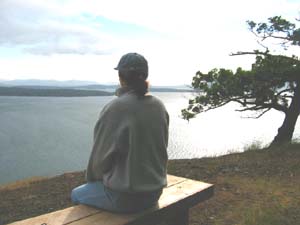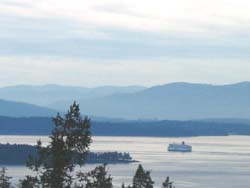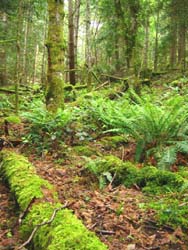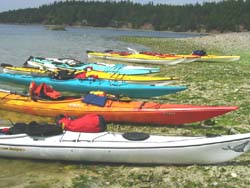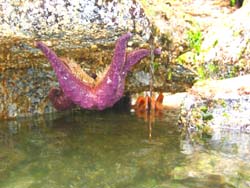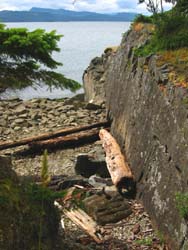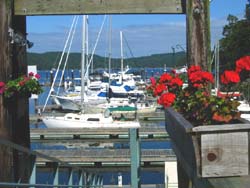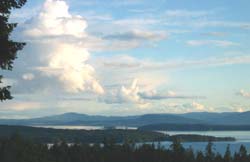|
|
||||
The
Gulf Islands: Driving the station wagon crammed with our worldly possessions aboard the Queen of Nanaimo at Vancouver's Tswassen terminal, we passed a young walk-on passenger. Carrying only a 12-pack of beer and a frisbee, he was a sign that our new west-coast life would be easy-going and relaxed. |
||||
Enjoying
one of the many sunset viewpoints |
||||
My wife and I were on the final leg of moving from land-locked southern Ontario to our new home in the Gulf Islands. As the ferry chugged into Georgia Strait we were instantly enthralled by the watery world. The sun sparkled from the waves, fishing boats trolled the waters, a powerful tug pulled a barge on a long line and sailboats floated like butterflies. Soon we were in the midst of a maze of rocky islands that stretched
in all Our first stop was Galiano
Island where a few cars clunked off the ramp and At Pender Island,
we drove off the ferry and to our new home, a cabin in a Day after sunny day followed, for the Gulf Islands lie in the rain
shadow We discovered the islands have two very different personalities:
the sea One day we went sea kayaking. The tide was out revealing a glistening mudflat with an oyster catcher and a long-legged blue heron patrolling for dinner. Rising and falling with the waves we witnessed an amazing abundance of marine life. The tour leader found a large red crab hiding inside a soft moon-snail shell. Purple starfish were attached like glue to rocks. An eagle sat regally high in a fir tree next to its massive nest. Thirty seals basking on a small islet watched us paddle past. Our guide described the graceful black and white orcas, or killer whales, that inhabit this strait. Three pods of about 90 orcas live here and the ultimate thrill, he explained, is to watch the graceful movements of these powerful mammals from a nearby kayak. Although boatless, we wanted to explore the nautical character of the Islands for they offer some of the best boating in the world. We solved the problem by visiting Poets Cove on south Pender Island. Set in a secluded cove this is the finest marina/resort in the Islands attracting boaters from California to Alaska. We spent hours on the dock watching the coming and going of sail boats with tall masts, gleaming yachts and roaring float planes. We walked the beaches toward the lighthouse peering into tidal pools and admiring the weathered driftwood logs that mark the high-tide line. At the bar we listened to yarns about fish that had been caught (or not), cruising the inner passage and the orcas, dolphins and sea lions that had been sighted. Our next exploration was to neighbouring Salt Spring Island, the largest (180 square kilometres) and most populated (10,000 inhabitants) of the Islands and a mecca for artists, authors and craftspeople. The inbound ferry passed large, elegant homes each with a boat dock and sleek yacht. Ganges, where we stayed at a lovely B&B, is the main town and is full of artisan shops, cafes, and restaurants serving fresh seafood. That afternoon we hiked a sea-side trail and watched ferries float regally past; then we tippled at one of the picturesque cottage wineries. But the highlight was the Saturday market, which was abuzz with pottery, paintings, carvings, sculptures, stained glass and other products of the human mind and hand. Pender, our island, is more isolated than Salt Spring with narrow winding roads and little night life. But it is achingly beautiful with numerous beach accesses and forest trails that often lead to “secret” glades or viewpoints where you can relax in privacy. One day I found a small cove where archeologists had unearthed an ancient Native midden (a buried refuse heap of an often centuries-old people). In this quiet spot I studied the perfectly preserved layers of tiny white shells as they curved up and down and pondered how the Coastal Salish Natives lived here for 4,000 years. At day's end, my wife and I often go to a favourite viewpoint and as the islands turn a misty blue-grey, we raise a glass to our new home. Hans recommends: Gulf Islands information Hans Tammemagi |
The ferry leaving the Pender Island terminal (our island home)
Deep in a forest glade in the Gulf Islands
Kayaks lined up and waiting on the beach
Starfish clinging to a rock at low tide
A quiet cove with driftwood
Poets Cove marina
The Gulf Islands perspective © 2005 All photographs by Hans Tammemagi |
|||
